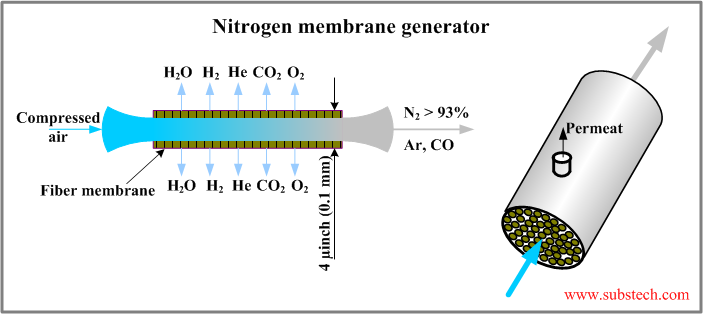Main page
About us
Sliding Bearings Consulting
Advertising Opportunities

Nitrogen membrane generator
Dr. Dmitri Kopeliovich
Nitrogen membrane generators separate Nitrogen from Oxygen and other air components due to their selective permeability through the wall of membranes.
Polymeric hollow fiber membranes with diameter of about 4 µinch (0.1 mm) are used in nitrogen generators.
Principle of operation of a gas separation membrane:
When air enters the bore of a hollow fiber membrane the gas molecules starts to diffuse through the fiber wall.
Molecules of some of the air components such as water vapor (H2O), Hydrogen (H2), carbon dioxide (CO2) and oxygen (O2) diffuse faster than molecules of nitrogen (N2) and Argon (Ar).
As a result the gas coming out from the hollow membrane is enriched with the “slow” components (nitrogen and argon).
The flow rate of the gas passing through the fiber bore determines the content of the “fast” components (oxygen, etc.) in the nitrogen enriched product.

An encased bundle of fiber membranes (up to 1 mln.) forms a gas separation module.
Pressurized (compressed) air at the pressure of up to 225 psi (15.5 bar) is fed to the module through a system of air driers and filters.
Oxygen rich gas (permeat) diffused through the membrane wall is coming out to the atmosphere through the vent in the module case.
One module of a nitrogen membrane generator may produce up to 100000 SCFH (2800 m3/h).
The advantages of nitrogen membrane generators:
- Simple: no moving parts, low maintenance.
- Cost effective: low investment, low operating cost.
- No high pressure tanks are required.
- The nitrogen purity (up to 99.9%) may be adjusted by varying the air flow rate, pressure and temperature.
Related internal links


